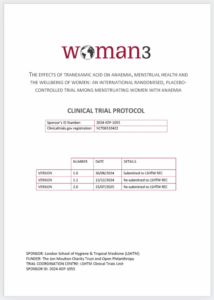
Protocol sumary
BACKGROUND: World-wide, half a billion women of reproductive age are anaemic. Anaemia has major health consequences for pregnant women and their babies. Anaemia increases the risk of ante-partum haemorrhage, prematurity, stillbirth, neonatal death, post-partum haemorrhage and maternal death. Unfortunately, global efforts to reduce anaemia prevalence by 2025 are far off track. Anaemia worsens bleeding through multiple biological mechanisms. Anaemia increases blood flow from bleeding vessels due to reduced blood viscosity and anaemic blood clots are more susceptible to fibrinolysis. Although iron and multivitamin replacement is the mainstay of anaemia treatment, iron stores in young women depend more on menstrual iron loss than on dietary intake. Because anaemia worsens bleeding, women with anaemia have heavier periods than if they were not anaemic. For this reason, offering iron replacement without reducing menstrual iron loss may be inefficient. The antifibrinolytic drug tranexamic acid (TXA) reduces menstrual bleeding by preventing blood clot breakdown. We propose that giving TXA with iron and vitamin replacement will be more effective in treating anaemia than iron and vitamin replacement alone.
AIM: Determine the effect of giving TXA during menstruation for anaemia treatment.
PRIMARY OUTCOME: The proportion of women with anaemia (Hb<120 g/L, venous blood tests) at the end of the intervention period (6 completed menstrual cycles, i.e., about 6 months).
SECUNDARY OUTCOME: Haemoglobin concentration, serum ferritin (marker of iron storage, venous blood tests); participant reported menstrual blood loss, health and wellbeing; and adverse effects.
TRIAL DESIGN: An international, multicentre, randomised controlled trial of TXA versus placebo in 4,000 women.
POPULATION: Adult women with anaemia (Hb<120 g/L) who menstruate.
INCLUSION CRITERIA: Adult women with anaemia (Hb<120 g/L) who menstruate.
EXCLUSION CRITERIA: Women taking TXA, women with known contra-indications to TXA treatment (including allergy to TXA, renal impairment, active thromboembolic disease, history of venous or arterial thrombosis, history of convulsion) and women who plan to become pregnant during the trial period.
TRIAL TREATMENT AND REFERENCE THERAPY: Tranexamic acid 1 gram orally taken three times a day from the first to the last day of the menstrual period for up to 5 days, for 6 successive periods. The comparator is matching placebo. In addition, women will receive standard of care iron and folic acid supplementation orally for three months from enrolment.
SETTING: Educational settings in Nigeria, Tanzania, and Pakistan.
DURATION OF TREATMENT AND PARTICIAPATION: We will ask participants to take the trial treatment for 6 menstrual periods. Participants will also take standard of care supplements of iron and folic acid 3 months from enrolment. Trial participation ends after primary outcome assessment after the 6th menstrual period (or 9 months (+/- 1 week) after randomisation, whichever occurs first).
CRITERIA FOR EVALUATION: All those allocated to receive TXA will be compared to those allocated to receive placebo, whether they received the allocated treatment or not (intention-to-treat analysis).


